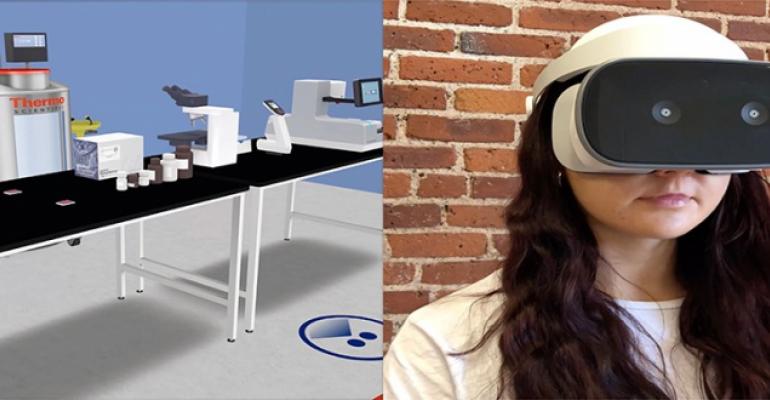Technological innovation in healthcare is growing at an increasingly fast pace across specialties, and the laboratory is no exception. Against the backdrop of increasing digitisation, various processes and structures have to be reconsidered in the laboratory of the future. Network-capable laboratory devices with intelligent and smart functions, complex holistic automation concepts and efficient interface solutions are indispensable for the start of the new era.
For instance, computational tools can enable laboratory managers to address the developing complex medical environment. Kaon Interactive’s Laboratory Design Tool (LDT), for example, offers companies the opportunity to share newly configured labs with internal stakeholders, to gain consensus buy-in on floorplans, equipment purchases, workflow efficiencies and more. In just minutes, the LDT enables laboratory managers, instrument sales and marketing teams, and lab scientists to configure entire laboratories and immediately immerse users in a newly designed lab.
To achieve this, the Kaon LDT offers three unique ways to visualise and experience a new, engaging, 3D, interactive laboratory layout: interactive 3D, untethered Virtual Reality (VR) and scalable Augmented Reality (AR) with real-time 3D object placement (instruments, consumables, chairs, workstations, windows, doors, pipette drying racks, sinks, etc.).
Users start configuring their lab either by free drawing a layout themselves or selecting from pre-defined labs that meet their specific business needs. Once a floorplan has been selected or created, instruments and furnishings may be added from a library of objects, using a simple drag-and-drop action. These 2D floor plans instantly become 3D immersive at the touch of a button.
The Kaon LDT is customisable to allow data-driven product and workflow suggestions for unique laboratory layouts, revealing differentiated value through calculated impact such as assay volume, energy and space requirements, and even staffing modifications. It also helps demonstrate future layout evolutions by supporting comparisons between existing and new workflows, validating proper fit and flow, optimising space, improving efficiency, lowering operational costs, reducing sample loss contamination, and more.
Excerpts from an interview with Dana Drissel, Vice President of Marketing, Kaon Interactive.
What has been the impact of advancements such as Point-of-care-testing (POCT), Big Data, and personalized medicine on the laboratory industry?
The ultimate goal of “Big Data” is to provide timely insight that is used to improve the effectiveness and efficiency of organisations. Within a laboratory, companies now have the ability to analyse collected data using visualisations and other techniques to uncover insights around their people, processes and systems. The challenge is then how to act on these key findings in real time to create effective clinical management, optimal patient care and improve the overall laboratory process.
According to you, how essential is automation in labs today?
Lab automation not only decreases human error associated with sample preparation, but it also increases efficiency in the lab by allowing the user to track samples. This type of productivity is imperative in today’s labs to reduce costs and increase walk away time for scientists.
"Within a laboratory, companies now have the ability to analyse collected data using visualisations and other techniques to uncover insights around their people, processes and systems." - Dana Drissel
Tell us about Kaon’s Laboratory Design Tool. What are its applications?
Kaon Interactive’s LDT is a first-of-its-kind interactive laboratory plan and design tool that uses 3D, augmented reality and virtual reality to visualise laboratory configurations and communicate the unique benefits of lab products and services. It can be used to plan any medical lab or operating room design prior to purchasing equipment or committing to construction plans. The LDT empowers multiple constituents within the laboratory ecosystem to visualise complex instruments, equipment and workflows in a “virtual” layout. It’s customisable to allow data-driven product and workflow suggestions for unique laboratory layouts, revealing differentiated value through calculated impact such as assay volume, energy and space requirements, and even staffing modifications. It also helps demonstrate future layout evolutions by supporting comparisons between existing and new workflows, validating proper fit and flow, optimising space, improving efficiency, lowering operational costs, reducing sample loss contamination, and more.
What are the challenges faced by the laboratory industry currently and what does the future look like?
What we were hearing within the life sciences industry is that many labs were mapped out via Post-It note or simple drawings. As you can imagine, that allows much room for error and only gives a mental picture of the final product. We wanted to personalise the experience and designed the LDT to bring a lab to life via 3D, augmented reality and virtual reality to help designers truly “visualise” it in the early planning stages. What’s more, it allows you to virtually transport into the space, getting a feel for the room, the spacing, flow, etc., allowing for a uniquely memorable experience. We predict that visual interactive applications like the LDT will become a requirement in the digital transformation for B2B enterprises, including life sciences companies.

